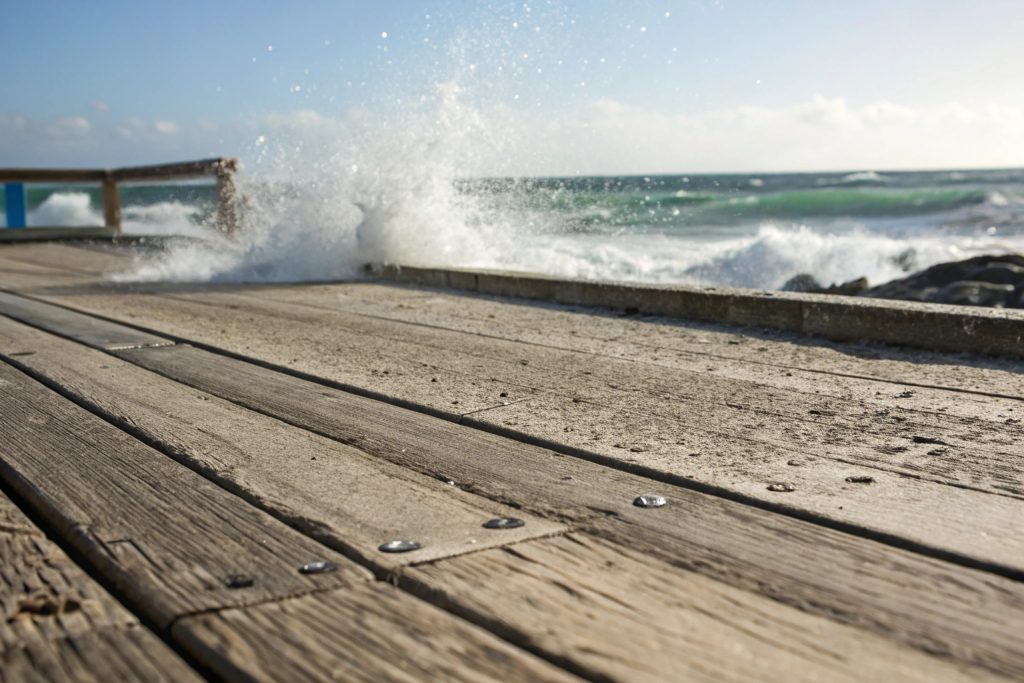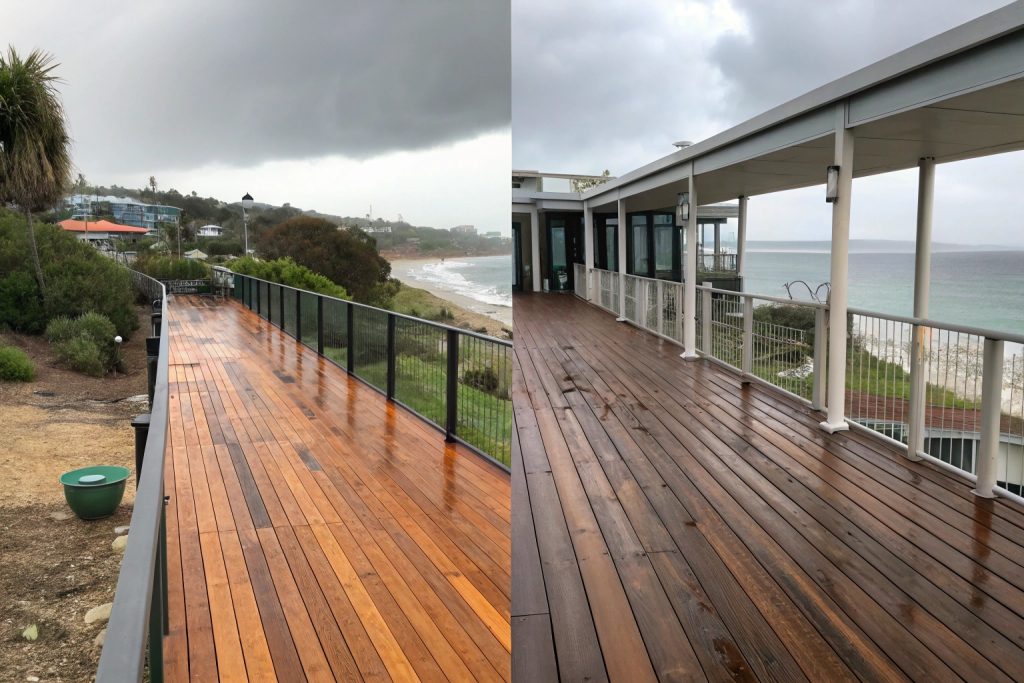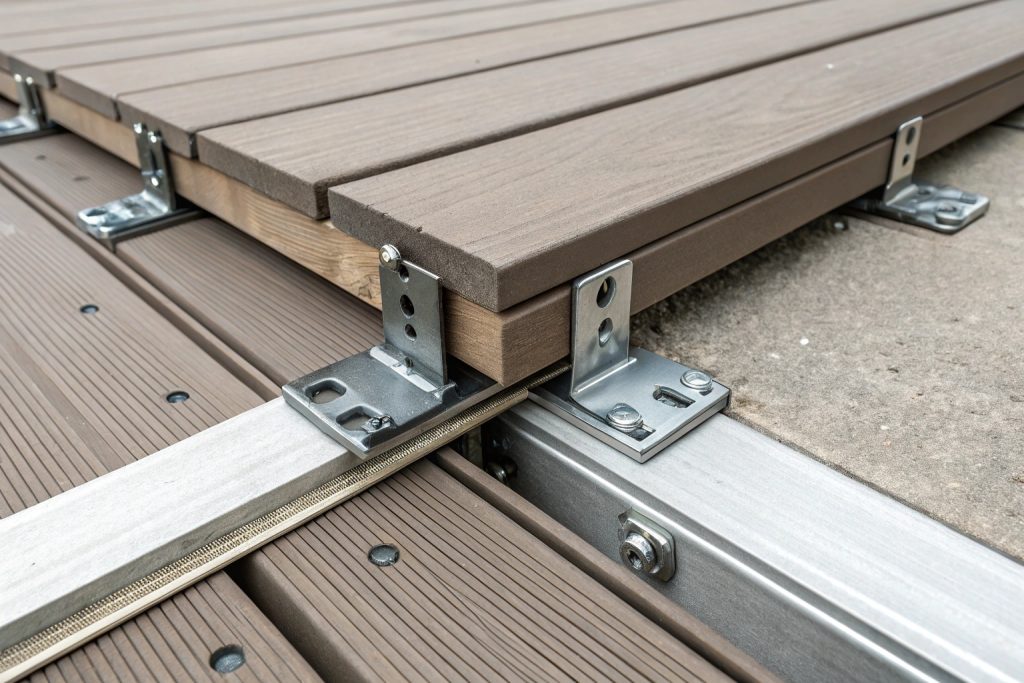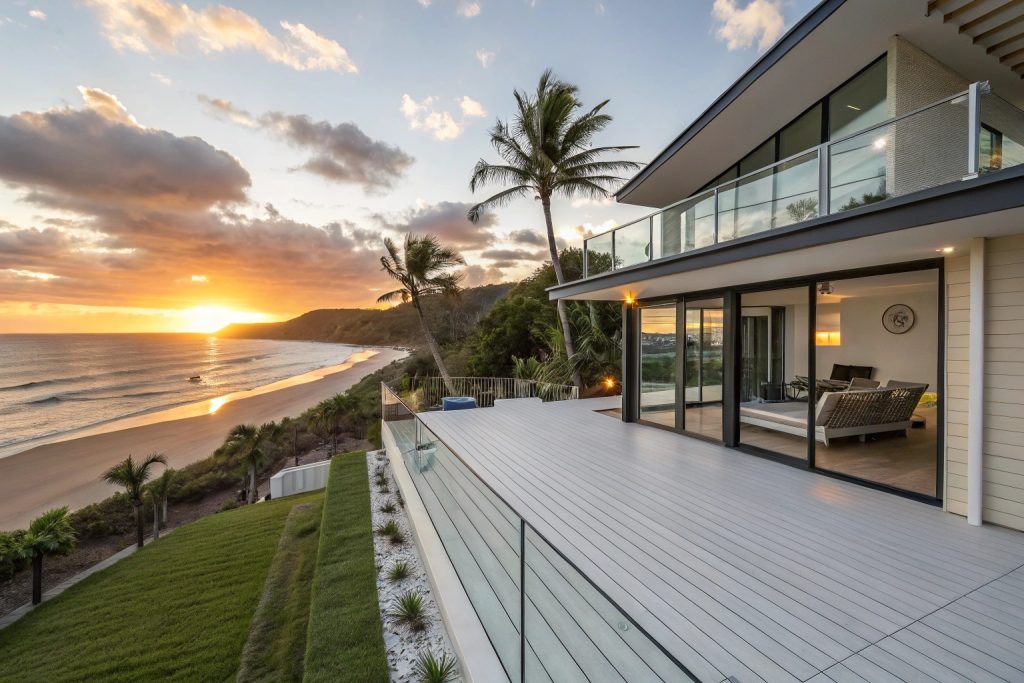Choosing between a multi-level and single-level deck is one of the biggest decisions homeowners face…
Best Decking Materials Palm Beach Beachfront Homes
Living by the beach in Palm Beach is amazing, but it sure puts our outdoor spaces through the wringer. Salt spray, intense sun, and those summer storms can destroy regular decking in just a few years. When investing in a deck for your beachfront property, you need materials that can handle everything our Gold Coast weather throws at them. The wrong choice means wasted money and weekends spent on repairs instead of enjoying those gorgeous ocean views with a cold drink in hand.
As someone who’s been building decks along Palm Beach’s coastline for years, I’ve seen firsthand which materials excel and which fail when placed within meters of saltwater. The best decking materials Palm Beach beachfront homes need are different from what works just a few kilometres inland.
In this guide, I’ll explain exactly what works for our unique coastal conditions, how much you’ll really end up spending over time, and which specific products I recommend to my clients depending on how close they are to the shoreline.
Composite Decking Options Engineered for Extreme Coastal Exposure
The toughest environment for any deck is right on the beachfront, where salt spray hits daily. Most of my Palm Beach clients have figured out that composite decking is worth every penny in these extreme conditions.

Today’s high-performance composites aren’t like the fake-looking products from 10 years ago. The latest generation uses advanced tech to create boards that can handle our brutal Queensland sun and salty air without fading or breaking down.
Here’s what makes certain composites perfect for Palm Beach beachfront decks:
- Co-extruded caps – The best boards have a protective shield completely surrounding the core that blocks UV rays and prevents moisture absorption
- Colour mixed throughout – When the colour goes all the way through, minor scratches don’t show up like they do on painted surfaces
- Salt-tested formulations – Top brands are specifically tested for salt spray resistance
One of my recent clients on Ocean Avenue chose Trex Transcend in Island Mist for their oceanfront deck. After three summers, it still looks basically new despite being less than 50 meters from high tide. The subtle grey colour also doesn’t show salt residue like darker options do.
A word of caution, though – not all composites are created equal. The cheapest hollow core options at hardware stores aren’t made for beachfront homes and will sag and fade quickly. This is one area where buying premium actually saves money in the long term.
Premium Hardwoods That Withstand Palm Beach’s Ocean Environment
While composites are brilliant, some of my Palm Beach clients still prefer the natural look of real timber. If that’s you, certain hardwoods can perform exceptionally well even in harsh coastal conditions.
The key is choosing species with natural oils and density that resist both insects and decay. My top recommendations for Palm Beach beachfront decks are:
- Spotted Gum – This Australian native is perfect for our climate and develops a beautiful silver patina over time
- Ironbark – Incredibly dense and naturally resistant to termites, perfect when durability is your primary concern
- Merbau/Kwila – Contains natural oils that resist salt damage, though it requires more maintenance to prevent tannin leaching
- Ipe – The gold standard imported option, so dense it barely floats and can last 30+ years, even oceanside
I built a gorgeous Spotted Gum deck for a family in North Palm Beach last year. They love how it’s slowly developing character while staying strong against the elements. The natural variations in the wood grain also hide salt deposits between cleanings.
The downside? These premium hardwoods need regular maintenance. Plan on oiling or sealing every 6-12 months for beachfront applications. Some clients find this therapeutic while others hate the ongoing commitment.

Hidden Fastening Systems That Prevent Salt Air Corrosion
One aspect of beachfront decking that often gets overlooked is the fastening system. Standard deck screws can rust within months in Palm Beach’s salty air, leaving ugly rust stains and eventually failing completely.
For the best decking materials Palm Beach beachfront locations demand, you need fasteners specifically designed for marine environments:
- Stainless steel clips – These hidden fasteners create a clean look while resisting corrosion
- Titanium-coated screws – If visible screws are necessary, these offer superior salt resistance
- Thermal-coated systems – Advanced polymer coatings provide an extra barrier against moisture
The best system I’ve found for beachfront decks combines stainless steel hidden clips with composite boards. This approach gives you a barefoot-friendly surface with no exposed metal to corrode. For timber decks, specially designed stainless screws with matching timber plugs provide both strength and aesthetics.
A client on Cypress Avenue had their original deck installed with standard galvanised screws. Within 8 months, rust stains were bleeding down the sides of their beautiful timber. We replaced everything with a proper marine-grade system, and three years later, it’s still pristine.
Colour Retention: Which Decking Materials Resist UV Fading Longest?
The Queensland sun is absolutely brutal on outdoor materials. I’ve seen some decks fade dramatically within a single summer, especially darker colours that absorb more heat.
For Palm Beach beachfront homes, colour retention becomes a major factor in material selection:
- High-end composites – The top-tier products have the best fade resistance, typically changing less than 5% over 10+ years.
- Capped PVC decking – Fully synthetic options without wood fibres often hold colour better than traditional composites
- Spotted Gum and Ironbark – These naturally weather to an attractive silver-grey rather than an uneven, patchy look
- Cedar and pine – These budget timbers fade quickly and unevenly (avoid for beachfront)
I always recommend mid-tone colours for Palm Beach beachfront decks. They hide salt residue better than dark shades while showing less dirt than very light options. Greys and weathered browns tend to age most gracefully in our coastal environment.
One thing to remember – even the best materials will show some colour shift over time. It’s the nature of anything exposed to our intense Queensland sunshine. The difference is whether that aging happens evenly and attractively or in blotchy, unsightly patterns.

The True Cost Comparison: Initial Investment vs. Lifetime Value
Let’s talk money. Your Palm Beach beachfront deck is going to cost more than one built further inland – that’s just reality. But comparing just the upfront price is incredibly misleading.
Here’s what the true cost looks like over a 25-year period for a standard 40m² deck:
| Material | Initial Cost | Replacement | Total Ownership Cost plus Maintenance |
| Budget Pine | $8,000+ | 2-3 replacements | $40,000+ |
| Spotted Gum | $12,500+ | Maybe 1 replacement | $25,000+ |
| Premium Composite | $14,000+ | None needed | $16,500+ |
| PVC Decking | $30,000+ | None needed | $31,500+ |
These numbers might seem surprising, but they come from real-world experience with Palm Beach beachfront properties. The cheapest options upfront actually cost way more long-term because of our harsh coastal conditions.
I had a client on Beach Road who initially balked at spending $14,000 on a premium composite deck. After showing him these numbers, he understood the value proposition.
The lesson? When you’re building a beachfront deck in Palm Beach, investing in quality materials isn’t a luxury – it’s actually the most economical choice.
Expert Recommendations for Different Proximity Zones to the Ocean
The perfect decking material changes depending on exactly how close you are to the surf. I’ve developed specific recommendations based on proximity zones:
Immediate Beachfront (0-100m from high tide)
This is the most challenging environment where salt spray is a daily reality:
- Best option: Premium capped PVC decking
- Good alternative: High-end composite with specific marine warranty
- Timber option: Ipe or Ironbark with a 6-month maintenance schedule
Near-Beach (100-500m from shore)
Salt exposure is still significant but somewhat reduced:
- Best option: High-performance composite
- Good alternative: Spotted Gum with annual maintenance
- Budget-friendly: Merbau with diligent 6-month maintenance
Coastal Neighbourhood (500m-2km inland)
Still affected by sea air but with much less direct salt spray:
- Best option: Standard composite decking
- Good alternative: Spotted Gum or Blackbutt with annual maintenance
- Budget-friendly: Treated pine with proper marine-grade treatment
I recently completed three different decks within these zones in Palm Beach, and the performance difference is already noticeable. The materials that excel right on the beachfront are sometimes overkill just a kilometre inland.
For example, a client in central Palm Beach (about 1.5km from the shore) has had great success with a quality Blackbutt deck that would struggle if placed right on the beachfront. The reduced salt exposure makes a massive difference in performance.
When choosing the best decking materials Palm Beach beachfront homes require, your exact location matters tremendously. I always visit the specific site before making recommendations because even small variations in exposure can affect material performance.

Final Thoughts on Beachfront Decking Materials
Building a deck for your Palm Beach beachfront home is a significant investment, but with the right materials, it can provide decades of enjoyment with minimal maintenance.
In my experience, premium composites and PVC decking offer the best overall value for properties directly facing the ocean. For those who prefer natural timber, selecting the right hardwood species and committing to regular maintenance can also provide excellent results.
Whatever you choose, don’t compromise on fasteners and substructure materials. Even the best decking will fail prematurely if installed with hardware that can’t handle our coastal conditions.
If you’re planning a beachfront deck in Palm Beach, I’d be happy to provide a personalised assessment of your specific location and needs. The perfect deck starts with choosing materials specifically suited to your exact coastal conditions.
